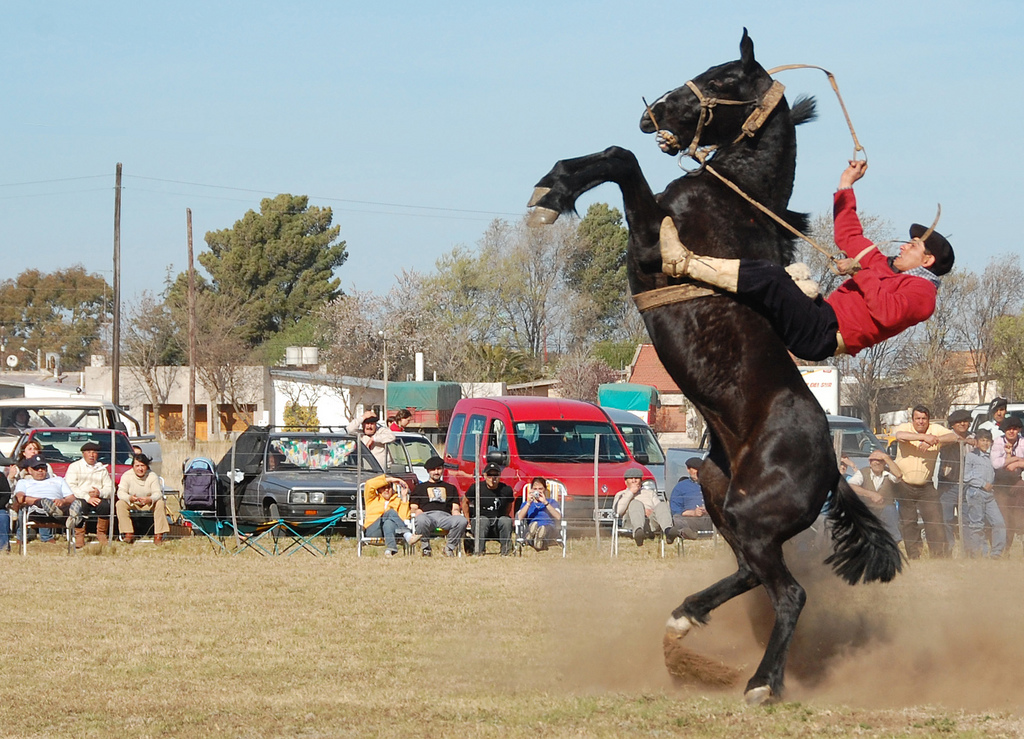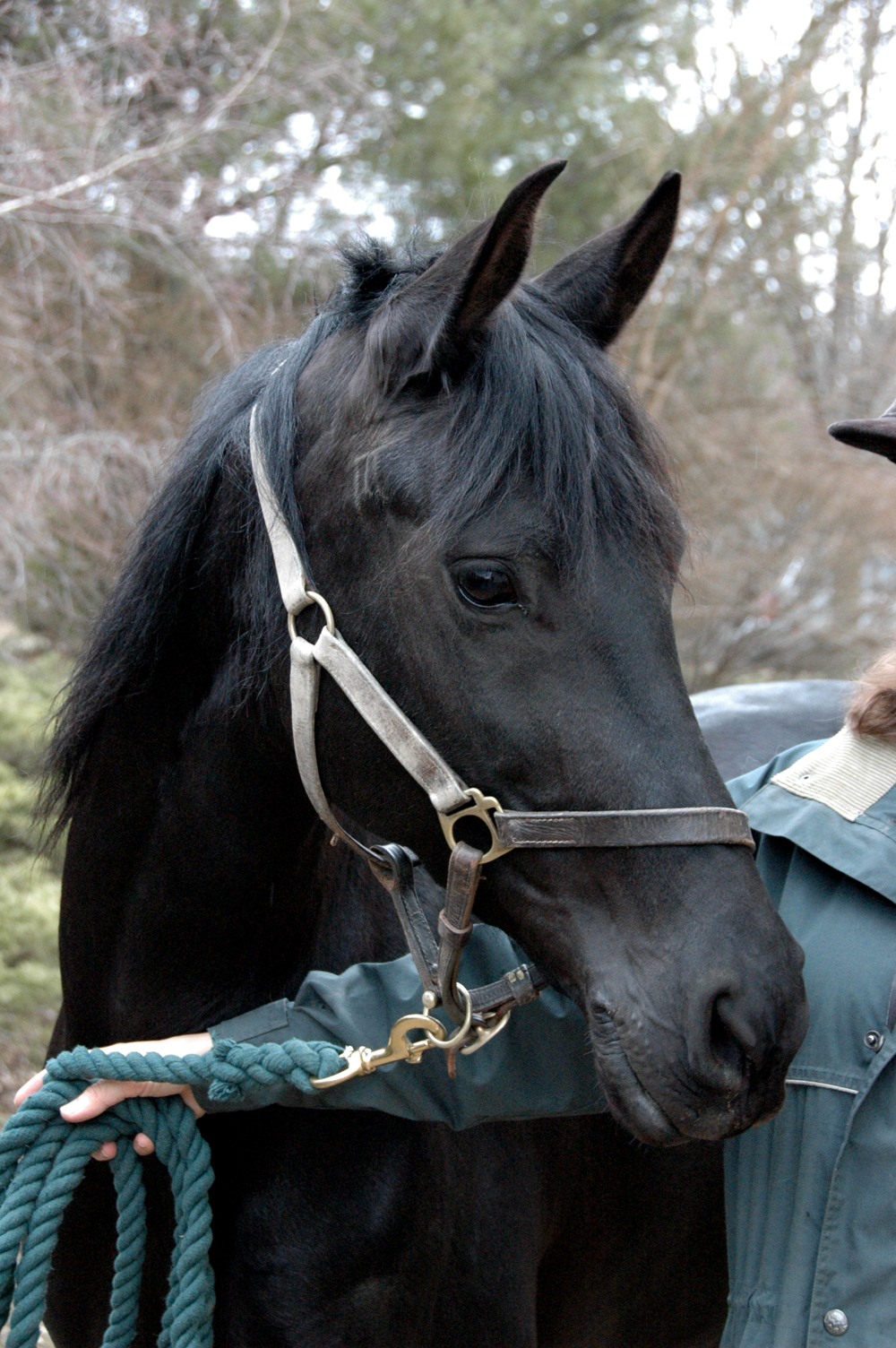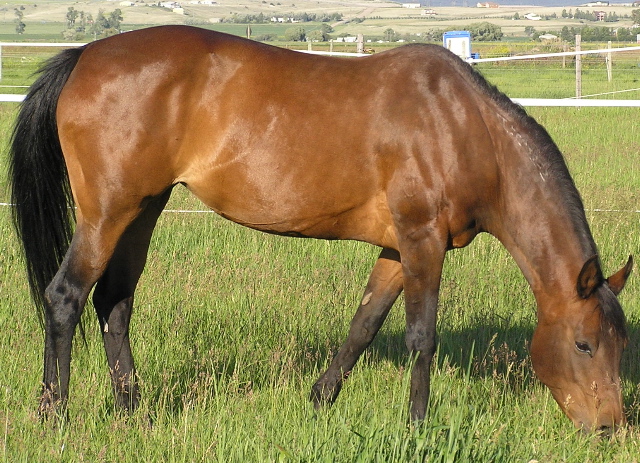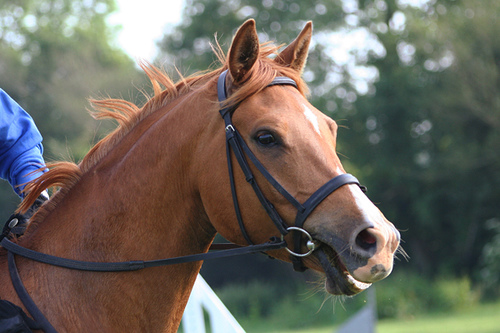|
Rearing (horse)
Rearing occurs when a horse or other equidae, equine "stands up" on its hind legs with the forelegs off the ground. Rearing may be linked to fright, aggression, excitement, disobedience, non experienced rider, or pain. It is not uncommon to see stallions rearing in the wild when they fight, while striking at their opponent with their front legs. Mares are generally more likely to kick when acting in aggression, but may rear if they need to strike at a threat in front of them. When a horse rears around people, in most cases, it is considered a dangerous habit for riding horses, as not only can a rider fall off from a considerable height, but also because it is possible for the animal to fall over backwards, which could cause injuries or death to both horse and rider. It is therefore strongly discouraged. A horse that has a habit of rearing generally requires extensive retraining by an experienced horse trainer, and if the habit cannot be corrected, they horse may be deemed too ... [...More Info...] [...Related Items...] OR: [Wikipedia] [Google] [Baidu] |
Knabstrupper Baron
The Knabstrupper or Knabstrup is a Danish Horse breed, breed of warmblood horse. It is principally a riding horse, but is also used as a harness horse and as a Circus#Animal acts, circus animal. It is broadly similar to the Frederiksborger, but often has a Leopard complex, spotted coat. In the past, injudicious selective breeding, breeding for this characteristic alone compromised its constitution and conformation. In the years after the Second World War the mechanisation of agriculture led to a sharp fall in numbers, and by the 1960s no more than 100 of the horses remained. In the twenty-first century it is an endangered breed, with a world-wide population estimated at little over . History The Knabstrupper descends from a single mare believed to have originated in Spain who showed qualities of endurance and speed, and was of an unusual colouration: a deep red () with a white tail and mane, and white flecks or "snowflakes" over her whole body and brown spots on her back. She ... [...More Info...] [...Related Items...] OR: [Wikipedia] [Google] [Baidu] |
Horse Tack
Tack is equipment or accessories equipped on horses and other equines in the course of their use as domestication of the horse, domesticated animals. This equipment includes such items as Saddle, saddles, Stirrup, stirrups, Bridle, bridles, Halter, halters, Rein, reins, Bit (horse), bits, and harnesses. Equipping a horse is often referred to as tacking up, and involves putting the tack equipment on the horse. A room to store such equipment, usually near or in a stable, is a tack room. Saddles Saddles are seats for the horseback riding, rider, fastened to the horse's Back (horse), back by means of a ''Girth (tack), girth'' in English-style riding, or a ''cinch'' in the use of Western tack. Girths are generally a wide strap that goes around the horse at a point about four inches behind the forelegs. Some western saddles will also have a second strap known as a ''flank'' or ''back cinch'' that fastens at the rear of the saddle and goes around the widest part of the horse's belly. ... [...More Info...] [...Related Items...] OR: [Wikipedia] [Google] [Baidu] |
Lone Ranger
The Lone Ranger is a fictional masked former Texas Ranger who fought outlaws in the American Old West with his Native American friend Tonto. The character has been called an enduring icon of American culture. He first appeared in 1933 in a radio show on WXYZ (Detroit), conceived either by station owner George W. Trendle or by Fran Striker, the show's writer. Test episodes aired earlier on radio station WEBR in Buffalo. The radio series proved to be a hit, and spawned a series of books (largely written by Striker), an equally popular television show that ran from 1949 to 1957, comic books, and several films. The title character was played on the radio show by Earle Graser for some 1,300 episodes, but two others preceded him, according to ''The New York Times'': "a man named Deeds, who lasted only a few weeks; a George Stenius George_Seaton.html" ;"title="ctually George Seaton">ctually George Seaton according to the ''Los Angeles Times'' After Graser died in 1941, Bra ... [...More Info...] [...Related Items...] OR: [Wikipedia] [Google] [Baidu] |
David - Napoleon Crossing The Alps - Malmaison2
David (; , "beloved one") was a king of ancient Israel and Judah and the Kings of Israel and Judah, third king of the Kingdom of Israel (united monarchy), United Monarchy, according to the Hebrew Bible and Old Testament. The Tel Dan stele, an Canaanite and Aramaic inscriptions, Aramaic-inscribed stone erected by a king of Aram-Damascus in the late 9th/early 8th centuries BCE to commemorate a victory over two enemy kings, contains the phrase (), which is translated as "Davidic line, House of David" by most scholars. The Mesha Stele, erected by King Mesha of Moab in the 9th century BCE, may also refer to the "House of David", although this is disputed. According to Jewish works such as the ''Seder Olam Rabbah'', ''Seder Olam Zutta'', and ''Sefer ha-Qabbalah'' (all written over a thousand years later), David ascended the throne as the king of Judah in 885 BCE. Apart from this, all that is known of David comes from biblical literature, Historicity of the Bible, the historicit ... [...More Info...] [...Related Items...] OR: [Wikipedia] [Google] [Baidu] |
Bridle
A bridle is a piece of equipment used to direct a horse. As defined in the ''Oxford English Dictionary'', the "bridle" includes both the that holds a bit that goes in the mouth of a horse, and the reins that are attached to the bit. It provides additional control and communication through rein pressure (Oxford English Dictionary, n.d., para. 1). Headgear without a bit that uses a noseband to control a horse is called a hackamore, or, in some areas, a bitless bridle. There are many different designs with many different name variations, but all use a noseband that is designed to exert pressure on sensitive areas of the animal's face to provide direction and control. The bridle was devised by Indo-European herders of the Pontic-Caspian steppes to control horses between 3000 BC and 2000 BC. Parts The bridle consists of the following elements: * Crownpiece: The crownpiece, headstall (US) or headpiece (UK) goes over the horse's head just behind the animal's ears, at the pol ... [...More Info...] [...Related Items...] OR: [Wikipedia] [Google] [Baidu] |
Halter
A halter or headcollar is headgear placed on animals used to lead or tie up livestock and, occasionally, other animals; it fits behind the ears (behind the poll), and around the muzzle. To handle the animal, usually a lead rope is attached. On smaller animals, such as dogs, a leash is attached to the halter. History Halters may be as old as the early domestication of animals, and their history is not as well studied as that of the bridle or hackamore. The word "halter" derives from the Germanic words meaning "that by which anything is held." One halter design was patented in the United States by Henry Wagner of Toledo, Iowa February 13, 1894. Uses A halter is used to control an animal when leading on the ground, and as a restraint when tying them up. [...More Info...] [...Related Items...] OR: [Wikipedia] [Google] [Baidu] |
Lead Shank
A lead, lead line, lead rope (US) or head collar rope (UK), is used to lead an animal such as a horse. Usually, it is attached to a halter. The lead may be integral to the halter or, more often, separate. When separate, it is attached to the halter with a Shackle, heavy clip or snap so that it can be added or removed as needed. A related term, lead shank or lead chain refers to a lead line with a chain attached that is used in a variety of ways to safely control possibly difficult or dangerous horses if they will not respond to a regular lead. Variations A lead can be made from a variety of materials, including cotton, horsehair (woven or braided hair, usually from a horse's tail), leather, nylon or other synthetic materials. Lead ropes, as the name implies, are round and made of various types of rope, usually between 5/8 and 3/4 inch (about 2 cm) in diameter.http://www.sstack.com Halters and leads at Schneider's Saddlery Co. Lead lines are usually flat webbing ... [...More Info...] [...Related Items...] OR: [Wikipedia] [Google] [Baidu] |
Equine Nutrition
Equine nutrition is the feeding of horses, pony, ponies, mules, donkeys, and other Equus (genus), equines. Correct and balanced nutrition is a critical component of proper horse care. Horses are non-ruminant herbivores of a type known as a "hindgut fermentation, hindgut fermenter." Horses have only one stomach, as do humans. However, unlike humans, they also need to digest plant fiber (largely cellulose) that comes from grass or hay. Ruminants like cattle are foregut fermentation, foregut fermenters, and digest fiber in plant matter by use of a multi-chambered stomach, whereas horses use microbial fermentation in a part of the digestive system known as the ''cecum'' (or ''caecum'') to break down the cellulose. In practical terms, horses prefer to eat small amounts of food steadily throughout the day, as they do in nature when grazing on pasture lands. Although this is not always possible with modern stabling practices and human schedules that favor feeding horses twice a day, i ... [...More Info...] [...Related Items...] OR: [Wikipedia] [Google] [Baidu] |
Bit (horse)
The bit is an item of a horse tack, horse's tack. It usually refers to the assembly of components that contacts and controls the horse's mouth, and includes the shanks, rings, cheekpads and mullen, all described here below, but it also sometimes simply refers to the ''mullen'', the piece that fits inside the horse's mouth. The mullen extends across the horse's mouth and rests on the ''bars'', the region between the incisors and molars where there are no horse teeth, teeth. The bit is located on the horse's head by the , and which has itself several components to allow the most comfortable adjustment of bit location and control. The bit, bridle and reins function together to give control of the horse's head to the rider. The bit applies pressure to the horse's mouth, and reinforces the other control signals from the rider's legs and weight distribution. A well schooled horse needs little pressure on the bit from a skilled rider. Studies have indicated that soft, consistent bit co ... [...More Info...] [...Related Items...] OR: [Wikipedia] [Google] [Baidu] |
Saddle
A saddle is a supportive structure for a rider of an animal, fastened to an animal's back by a girth. The most common type is equestrian. However, specialized saddles have been created for oxen, camels and other animals. It is not known precisely when riders first began to use some sort of padding or protection, but a blanket attached by some form of surcingle or girth was probably the first "saddle", followed later by more elaborate padded designs. The solid saddle tree was a later invention, and though early stirrup designs predated the invention of the solid tree, the paired stirrup, which attached to the tree, was the last element of the saddle to reach the basic form that is still used today. Present-day saddles come in a wide variety of styles, each designed for a specific equestrianism discipline, and require careful fit to both the rider and the horse. Proper saddle care can extend the useful life of a saddle, often for decades. The saddle was a crucial step in ... [...More Info...] [...Related Items...] OR: [Wikipedia] [Google] [Baidu] |
Collection (horse)
Dressage ( or ; , most commonly translated as "training") is a form of horse riding performed in exhibition and competition, as well as an art sometimes pursued solely for the sake of mastery. As an equestrian sport defined by the International Equestrian Federation, dressage is described as "the highest expression of horse training" where "horse and rider are expected to perform from memory a series of predetermined movements". Competitions are held at all levels from amateur to the Olympic Games and World Equestrian Games. Its fundamental purpose is to develop, through standardized progressive training methods, a horse's natural athletic ability and willingness to perform, thereby maximizing its potential as a riding horse. At the peak of a dressage horse's gymnastic development, the horse responds smoothly to a skilled rider's minimal aids. The rider is relaxed and appears effort-free while the horse willingly performs the requested movement. The discipline has a rich hi ... [...More Info...] [...Related Items...] OR: [Wikipedia] [Google] [Baidu] |







